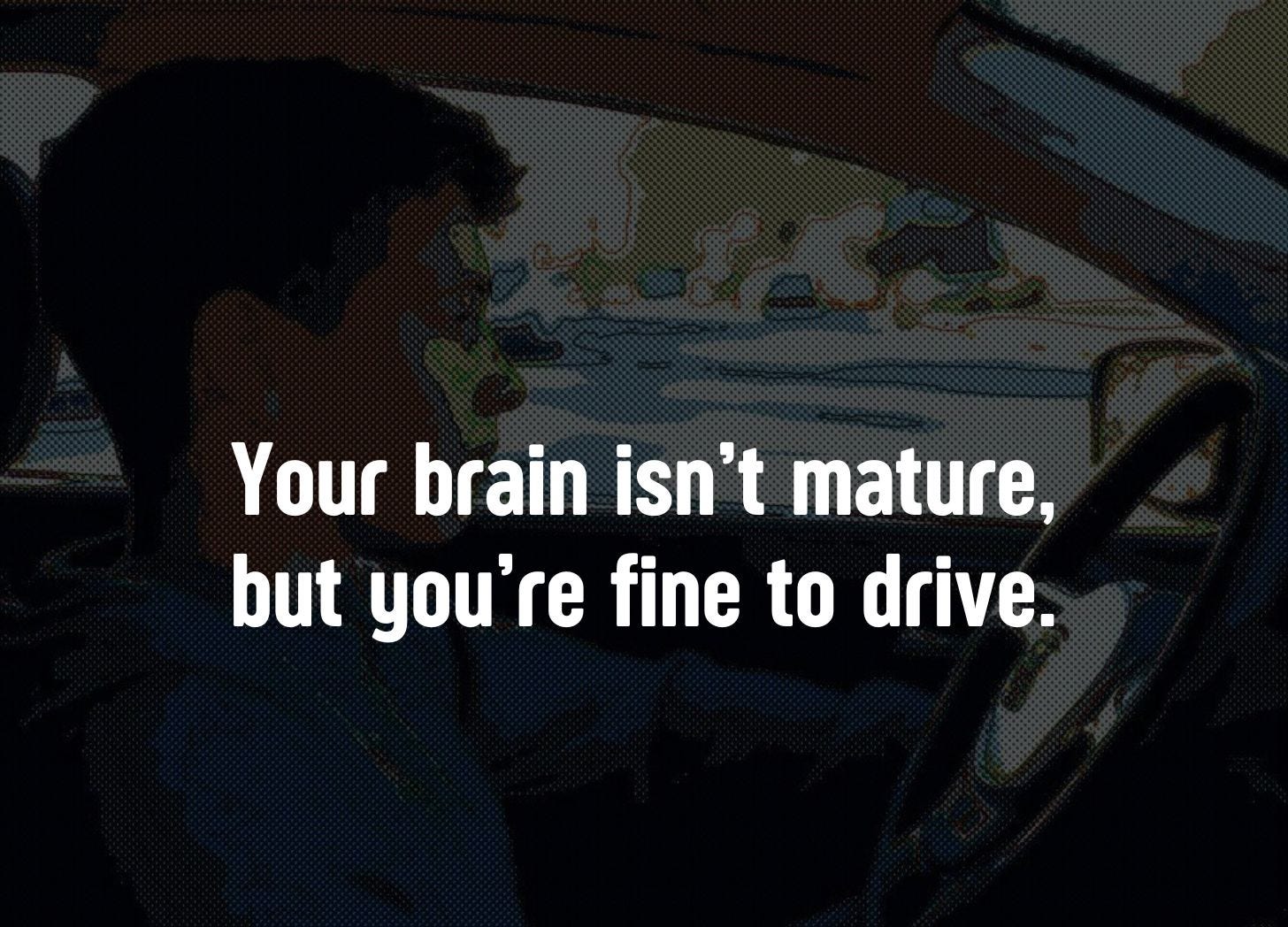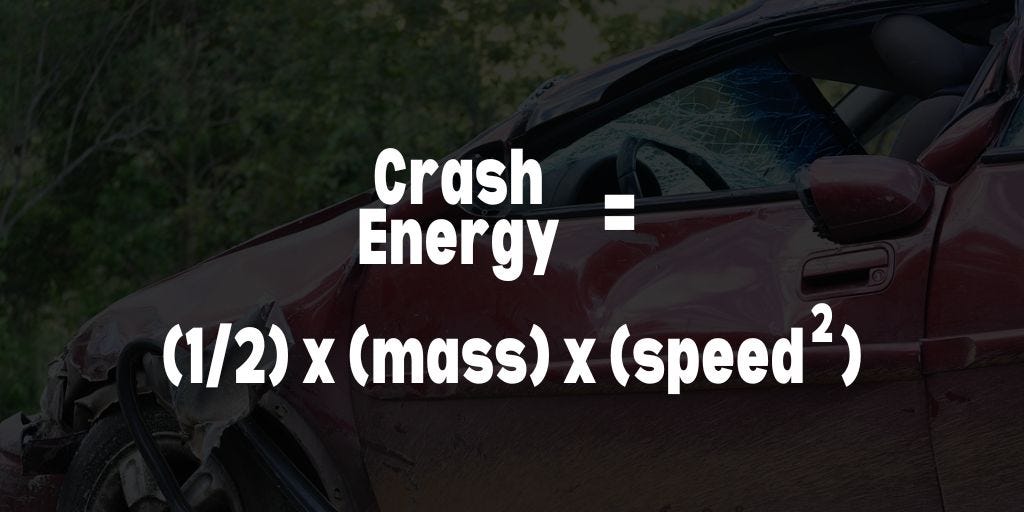The kids (driving) are not alright
Young drivers have the highest involvement in crashes of any age group. And culturally, we give a collective sigh and a "whaddya gonna do" shrug.
A child turns 16, and they're told they're not mature enough to
❌ vote.
❌ smoke a cigarette.
❌ sign a contract.
❌ get married.
❌ sit on a jury.
❌ own property.
But they're told they're totally mature enough to operate a 2-ton vehicle that can easily go 80 mph.
In the old TV show, kids say the darndest things, but any parent knows kids also do the dumbest things. Doctors say our brains are still figuring out decision-making and impulse control well into our 20s (older for boys than girls). Our 20s! The number makes me mad, but as a former 20-something boy, I can’t deny it.
Teens are known for driving...
while distracted by other kids
while texting
while intoxicated
without seat belts
while tired
too fast.
Should the minimum legal driving age reflect typical human maturity? Most 16-year-olds are not mature enough to operate today's motor vehicles. I find myself wishing the minimum driving age was higher, except for rare cases of demonstrated skill and maturity.
I struggle with this topic because I wholeheartedly support and promote childhood independence. Maybe it’s because I’m a Gen Xer who experienced unsupervised fun with friends and strangers. Maybe it’s because I have issues with authority. Maybe it’s because seeing the results of coddling parenting infuriates me. My struggle is that I want kids to thrive without heavy interference by grown-ups, but I am also fully aware that kids are terrible terrible drivers.
In the US, 5.1% of licensed drivers are under 20 years old, but they make up 12.6% of drivers in crashes. Child drivers have the highest involvement in crashes of any age group. Whether or not they realize it, traffic violence is a leading cause of death for teens. They have a higher fatal crash rates due to their immaturity and limited driving experience. Studies consistently report young drivers are more likely to engage in high-risk behaviors such as speeding, following too closely, and distracted driving. Their lack of experience means they often don't recognize or know how to respond to hazards, contributing to a crash rate that is nearly four times higher than drivers aged 20 and older per mile driven.
Risk: speed
In 2022, male drivers aged 15-20 were the most likely group to be speeding at the time of fatal crashes, with 35% involved in speeding-related incidents. Young female drivers in the same age group had a 19% speeding involvement rate in fatal crashes, which is still significant compared to other age groups.
Speeding contributes significantly to crash severity. Speeding was reported as a factor in 21% of serious crashes where teen driver error was the cause. But frankly, it’s probably closer to 100% of serious crashes when you consider physics:
The propensity to speed among young drivers is often linked to sensation-seeking traits. I’m not too old to remember the thrill of driving way-too-fast on neighborhood streets. Studies using virtual reality driving simulators have found that young adults with these traits tend to drive at faster average and maximum speeds. No surprise to anyone who studies psychology or sociology.
Risk: young passengers
13% of all passenger fatalities were passengers of teen drivers 13 to 19, and 57% of teen passenger fatalities 13 to 19 were passengers of teen drivers 13 to 19. Having another teen in the car with a teen driver increases the chances of a crash because immaturity compounds. (Each of the tables below is available on Insurance Institute for Highway Safety’s website.)
Crash risk increases with each additional teen or young adult passenger, with the risk doubling with two passengers and quadrupling with three or more. Sometimes it’s peer pressure, and sometimes it’s the desire to engage in risky behavior to show off.
Risk: nighttime driving
Teenagers also want to stay out late, but driving after dark is incredibly dangerous for them. They have a fatal crash rate at night about three times higher than during the day.
Risk: distractions
Distraction is another significant issue. Texting while driving is particularly alarming. The average “I was just checking my messages” distraction is equivalent to driving the length of a football field with closed eyes at 55 mph. 15-20-year-olds are 33% more likely to die in crashes related to distracted driving than the national average.
Risk: unbuckled
There's a concerning trend of inconsistent seatbelt use among teens, which exacerbates the risk of fatal or severe injuries in crashes. More than half of teen drivers and passengers killed in crashes were not buckled in.
What’s a parent to do?
Graduated Drivers License (GDL) helps. They’re designed to provide young and new drivers with a structured, step-by-step approach to getting experience behind the wheel. The USDOT says GDL programs can reduce teen crashes up to 50%. All 50 states and the District of Columbia have some form of GDL. As you might guess, states with more rigorous GDL systems generally see better safety outcomes. They progress like this:
Learner’s permit stage. Driving is only permitted under the supervision of a licensed adult, typically for a specified number of hours or months.
Intermediate (provisional) license stage. Often requires holding a learner's permit for a set period and passing a road test. They also can include restrictions about the time of day and number/age of passengers.
Full licensure. Passed the tests and kept a clean record.
Still, we know that even with a full license, a child’s brain still has years to go before it’s fully formed.
Some obvious (but socially unpopular) ways to protect kids from their own immaturity is to increase the minimum driving age, require use of speed limiters, and restrict the time of day for driving. In the meantime, traffic violence will continue to be one of the leading causes of death for children.
Like I said, I struggle with this because I don’t want to coddle kids. At the same time, as a parent of two under-25-year-old boys, I don’t want to pretend the kids are alright when it comes to operating 2-ton motor vehicles.
If you want to dig into teen driver stats more, some of the organizations that publish data on this stuff are:








The statistics are heartbreaking and difficult to deal with. As Gen x I have the same quandaries you do about the balance between saving lives and allowing kids to have some Independence.
But I think a major solution is being overlooked here, which is public transportation. Most teens have no choice but to drive if they're going to get where they want to go. They can't just hop a train in the suburbs and roll into downtown to meet their friends, or take a bus to a different neighborhood to hang out.
And I think it's important to acknowledge that for a lot of parents, the act of allowing their child to drive the car or even buying their teenager a car is a form of cultural initiation in America where car culture reigns supreme. I know that's a bigger problem, but still it strikes me as an important part of this whole issue.
Fun story - I once designed a new community next to a community college. We had a lovely boulevard-ish street design as a new street leading to the college, with a landscaped median and a 10 foot travel lane in each direction. The traffic engineer for the city told us he wanted wider lanes, because young people are bad drivers. He pushed for 13 foot lanes. Seriously. So I said - "the idea is they're bad, so we're going to encourage speeding and recklessness?" He had a hard time answering that, but still he insisted on "wider lanes = safer."